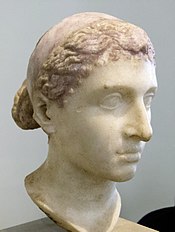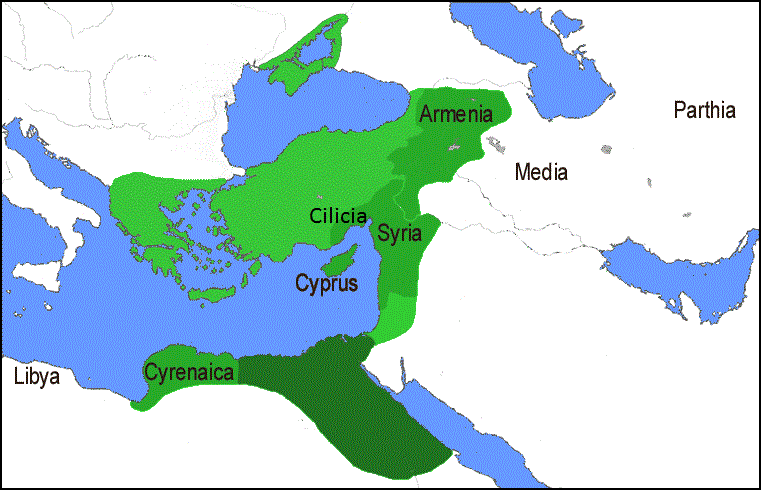Dynastic power in the Greco-Roman world

Cleopatra VII Philopator
The Greco-Roman world was often extremely violent. Protection from this violence comes from power over money and belief, which become the two battlegrounds within society.
There are severe limits on the power of an individual, no matter what wealth or faith that person controlled. The state, however, offers levers of power over both the economy - through taxation - and faith, through organised religion.
The most able in Greco-Roman society therefore fought, through means fair and foul, to place their hands on those levers of power.
The natural instinct of a family head is to protect the family and we therefore see throughout Classical Antiquity how individuals gaining power over the state will naturally try and form a dynasty, to provide an umbrella of protection over their immediate family and extended clan.
This is how the cognomen is so important: cognomen: Latin co, "together with," and nomen, "name"; the third name of a citizen of Ancient Rome, under Roman naming conventions.
In 242 BCE, the official number of Roman tribes was set at 35: Aemilia
Aniensis
Arniensis
Camilia
Claudia
Clustumina
Collina
Cornelia
Esquilina
Fabia
Falerna/Falerina
Galeria Horatia
Lemonia
Maecia
Menenia
Oufentina/Oufetina
Palatina
Papiria
Poblilia
Pollia
Pomptina/Pontina
Quirina
Romilia Sabatia/Sabatina
Scaptia
Sergia
Stellatina
Suburana
Teretina
Tromentina
Velina
Voltinia/Votinia
Voturia
The naming of names
In the early regal period of Rome, it appears that people were at first referred to by one name (e.g., Romulus, Manius). As Rome grew in area and population, a second, family name came into use. By the earliest days of the Republic, every member of a household had at least two names - praenomen, and the genitive form of the pater familias' name, which became a fixed and inherited nomen.
This binomial nomenclature was unique among Indo-European languages of that era. Also, the core part of the name (nomen) was the inherited gens name, not the given name (praenomen). This is probably why so few different praenomina were used.
Later in the Republic a cognomen was added to distinguish families within a gens, as the importance of the gens grew and the size of voting tribes required this differentiation. Thus patricians (nobility) commonly had three names (Tria Nomina). Although this system dates to the later 5th century BC, it was slow to take root, as it does not appear in official documents until the late 2nd century BC and was not common until the time of Sulla, right before the Empire. It was adopted even more slowly by non-patricians; the first examples of cognomina for plebeians date to c. 125 BC and it was not popular for another century.
In the Byzantine Empire (Eastern Roman Empire), old Roman naming conventions were gradually replaced by Greek ones, although Roman names themselves would have continuing influence.
As we follow the battles for dynastic power, control over tax and belief, understanding identity is critical. Records were kept then in a different manner than today (obviously) and due to both time and the destructive nature of these conflicts, many records are lost. We therefore have had to develop other means to determine identity.
In historical studies, prosopography is an investigation of the common characteristics of a historical group, whose individual biographies may be largely untraceable, by means of a collective study of their lives, in multiple career-line analysis. ("multiple career-line analysis (as the social scientists call it)", Lawrence Stone remarked, in "Prosopography", Daedalus 100.1 (1971), pp 46-71.)
Cognomina do not appear in official documents until around 100 BCE and as we noted (above) naming conventions changed in time. We therefore must use every means to try and determine the identities of individuals and clans in their struggles for power.

A dynasty is a family that has become an institution. Only an institution in this period has the ability to carry traditions, political ideas and beliefs forward in time, across generations, centuries and sometimes, across the globe.
We have mentioned often three successors of Alexander the Great - Lysimachus, Ptolemy and Seleucus - and the two great dynasties they formed in Persia and Egypt.
The last Ptolemaic queen of Egypt was Cleopatra VII and her children became part of two great, allied Roman dynasties: the gens Julia and the gens Antonia.
As we mentioned earlier, two children with Mark Antony were the twins Alexander Helios and Cleopatra Selene.
The names alone tell us that something very important was expected of these children and this would be related to belief. The Donations of Alexandria, through which the world was to be shared between them, are a forewarning of the conflicts to come, causing a fatal breach in Antony's relations with Rome and were amongst the causes of the Final War of the Roman Republic.

Map of the Donations of Alexandria (by Mark Antony to Cleopatra and her children) in 34 BCE.
This is the battleground for power - wealth and faith - in the coming centuries, between dynastic institutions in the Greco-Roman world.